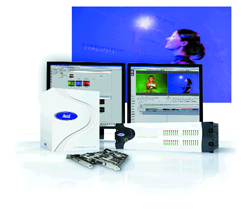
By David Jasse
PRODUCT: Avid DS Nitris
PRICING: $78,995 for DS Nitris Editor; $145,000 for DS Nitris (includes storage, compositing and effects tools). For existing Avid DS|HD customers, hardware upgrades to DS Nitris systems start at $35,000.
WEB SITE: www.avid.com
- works seamlessly with the family of Avid products
- HD realtime finishing
Let's put things in perspective. I've been editing on Avid Media Composers for over 10 years, and that's 10 years of seeing the name Tewksbury come up on my start-up screen. We'll for this assignment, I got to go to the infamous Tewksbury, MA, and see Avid Technology up close and personal... very cool. What was there to see? Well, there's an assembly line of very nice people building and testing those things, a wall with their 50 or so patents proudly displayed, their Oscar in a glass case, purple walls and flowers in the cafeteria, and my favorite, the giant number hanging from the ceiling... the countdown to NAB! We all need due dates! Ok, enough about my fun excursion out of my production office and onto DS Nitris.
Basically DS Nitris is a standard def and high def finishing tool, which offers power similar to After Effects, Photoshop and Illustrator - all in one system. Avid has come a long way since its relatively helpless title tool in the original Media Composer. For MC users, it's all the bells and whistles you ever wanted, rolled up into an extremely powerful hardware and software system. I was so excited to see that you can now add textures, blurs, soft edges to text, treat letters individually and have them animate over time, vector paint and all that good stuff in both 2D and 3D space. Since the characters are vector based, a la Illustrator, it allows you to maintain high resolution while stretching and bending the characters any way you like, in realtime. Most importantly it didn't seem like rocket science, I think the graphic tools are easy to use for MC 1000 users like me.
TONS OF FEATURES
It not only has a powerful 3D DVE, vector paint, motion tracking, keying, compositing, title and Symphony-like color correction tools, they work in HD - lots of processing power to say the least. As far as rendering is concerned, this system sings because it works off the host computer, meaning you can buy the fastest PC out there and it has hardware assist to carry the load. As far as protecting your hardware investment, they've taken that into consideration with the built-in ability to upgrade even the hardware without replacing it, with programmable media processors. The hardware can take updates via CD or the Web for things like future codecs, new effects or new products. How cool is that!
For those familiar with the robust DS, DS Nitris now uses the Media Composer-style interface for many of the DS features in order to get the best of DS capabilities into the hands of MC users. Not only can users now navigate better between the two systems, which is now one, but also the EDLs, or the AAFs (Advanced Authoring Format), speak pretty much the same language. In other words, when you create a complicated, effect-heavy timeline in the Media Composer, you don't lose parameters when you go into the DS, the timelines generally speak to one another. You're then ready to online your MC sequence with the advanced finishing tools within DS. I think the coders at Avid are breathing a sigh of relief after many years of merging the two systems. From a quick industry survey it seems to read almost all MC effects in the timeline.
At a recent visit to Northern Lights Post in Manhattan, senior editor/designer Ross Shain described how he imported a multilayered sequence in the AAF format into DS from Media Composer and it read everything including motion effects, Symphony-style color correction, Sapphire AVX plug-in FX and 12 layers of video, without having to re-create much if anything. According to Shain, the AVX 2.0 plug-ins don't come across from one to the other yet, but he says the overall compatibility is great. He said in the few cases where the FX don't come across it's usually not too tough to rebuild it in DS. For compositing, the system relies on a powerful and user-friendly tree-like logic structure native to many compositing tools. It's designed for creative artists who want the next step beyond timeline track stacking. For me as a producer who's used to working with separate artists, one for cutting, one for titles and another for 3D, it's an overwhelming thought that one editor/designer is not only going to be competent, but also creative with all three. As Shain pointed out, nowadays your typical Avid editor coming up knowing Photoshop, Illustrator and After Effects, so the learning curve might not be as daunting as it sounds.
DS Nitris's realtime capabilities are a great match for its project and system capabilities. Having to render, say, four hours worth of color correction would be quite an inconvenience for storage space and render time if not for its realtime capabilities. And not to close without mentioning audio, it's up there, with DS Nitris taking many high-end features from Digidesign Pro Tools.